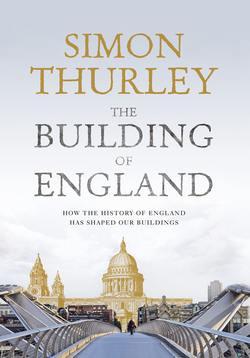Читать книгу The Building of England: How the History of England Has Shaped Our Buildings - Simon Thurley - Страница 28
The Normans and the English
ОглавлениеMany thought the death of Henry I in 1135 a calamity. He was the Conqueror’s last surviving son and was outlived by only one legitimate child, Matilda. Matilda was his agreed successor but his nephew Stephen darted across the Channel and was crowned before he could be stopped. This led to a period of disorder and uncertainty, often called the Anarchy, which was only resolved by Stephen’s death and the accession of Matilda’s son, Henry II, in 1153.
Henry II had huge strength of character, boundless energy, and a determination to re-establish order and the rule of law. His court was cosmopolitan and, through his marriage to Eleanor of Aquitaine, he presided over territories from Scotland to the Pyrenees. Henry was not a Norman king; he had Anglo-Saxon ancestry through his mother, and of his eight great-grandparents only William the Conqueror was Norman. But it was not only the monarchy that was no longer Norman. Families whose ancestors had arrived with the Conqueror had begun to see themselves as English; while the first generation of newcomers had usually been buried in Normandy, by the 1150s their children and grandchildren were buried in England.1
A sense of Englishness also becomes increasingly apparent in the work of a generation of historians writing between about 1120 and 1150. Henry of Huntingdon, for instance, set out to write the history of ‘this, the most celebrated of islands, formerly called Albion, later Britain, and now England’. His History of the English continued up to his own time and explained that the past victories of the Normans, including the Conquest of 1066, were now English history. This was in many respects true. The Norman ruling elite had married English women, adopted English laws and customs, assimilated native administrative structures, appropriated English history as their own and made pilgrimages to the shrines of Anglo-Saxon saints. In fact, although they didn’t speak English as their first language, the third generation of Normans were now Englishmen.2
Despite Henry II’s strength and success, he, no more than William the Conqueror, could control events after his death, and his sons Richard and John frittered away the territories and powers amassed by their father. Yet in many senses the reigns of Henry’s sons saw a further reinforcement of English identity: King Richard’s absence in 1191; the loss of Normandy in 1204; the interdict of 1208 (when the pope banned the administration of the sacraments in England) and the failed invasion of England by Prince Louis of France in 1216 – all these led to increasing insularity and even xenophobia.
This reinforcement was of great importance for the development of English architecture in the century or so after 1130. The growing wealth, self-confidence and identity of the English ruling class led to an energetic patronage of architecture. Magnates reorganised their estates, built themselves castles, and endowed churches and monasteries; bishops reconstructed their cathedrals and abbots built new abbeys. The style in which these buildings were constructed was ambitious, original and, with hindsight, English.3
